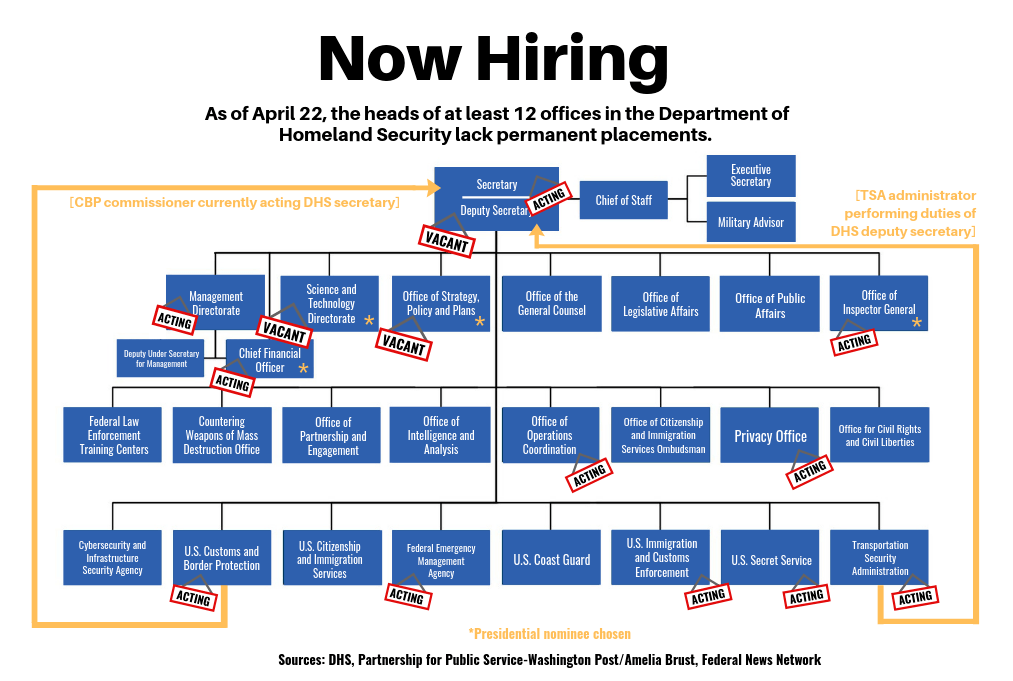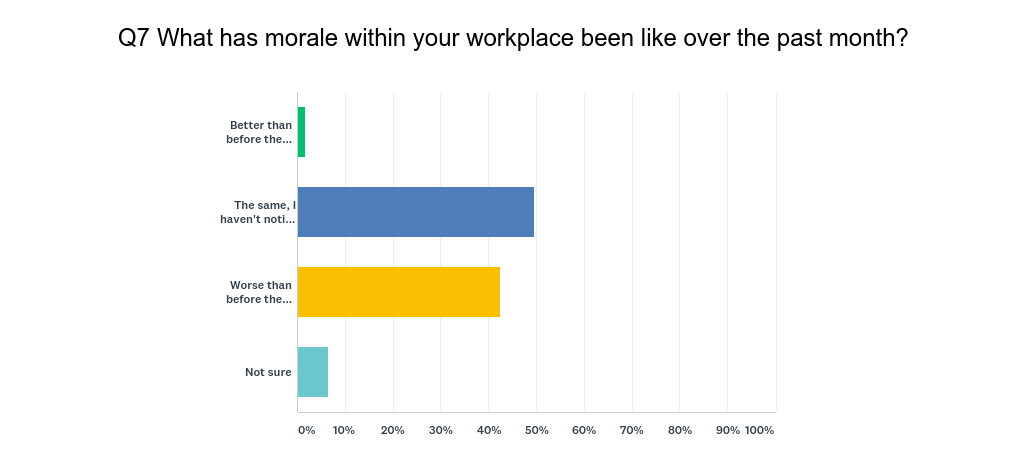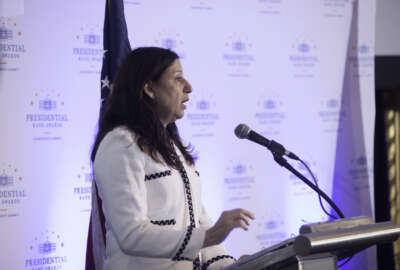DHS leadership changes may be unsettling publicly, but impact on workforce is limited
Though employees said DHS leadership changes have them feeling very or somewhat worried, a majority said the recent shakeups had little to no impact on their da...
This story has been updated on Wednesday, April 24 at 5:00 p.m. to correct information about the Secret Service director.
Best listening experience is on Chrome, Firefox or Safari. Subscribe to Federal Drive’s daily audio interviews on Apple Podcasts or PodcastOne.
When Kirstjen Nielsen, the now former secretary of the Department of Homeland Security, announced earlier this month that she was leaving, a few of the agency’s leaders quickly jumped into action emailing employees and organizing a town hall meeting.
“Those managers who understand employee engagement and understand morale reached out right away,” one DHS employee, who requested anonymity because they didn’t receive permission to speak to the press, said in an interview with Federal News Network. “They told us our job doesn’t change just because the leadership has changed. Our role is to enable the mission, and we have to do that — even if it means that some leaders have to go to more meetings or brief more people.”
It may be easy to look at recent DHS leadership changes and predict impending disaster for the department’s employees and their morale, productivity and mission.
But in a series of interviews and survey responses with Federal News Network, current and former Homeland Security employees and executives said the recent string of DHS leadership changes are an opportunity to communicate and remind the rank-and-file workforce of their mission to serve the American people.
 At just a little more than 15 years old, the Department of Homeland Security is no stranger to change. It’s part of the inherent nature of DHS’ multi-faceted mission. And even though the department is still relatively young in age and maturity, presidential and political transitions — where career executives are asked to step up and temporarily keep the trains moving — are nothing new to DHS.
At just a little more than 15 years old, the Department of Homeland Security is no stranger to change. It’s part of the inherent nature of DHS’ multi-faceted mission. And even though the department is still relatively young in age and maturity, presidential and political transitions — where career executives are asked to step up and temporarily keep the trains moving — are nothing new to DHS.
Yet the current situation — with at least 12 top positions either vacant or temporarily held by acting officials — is chaotic and unsettling, former DHS executives said, and current career leaders shouldn’t be surprised if recent shakeups leave some employees nervous.
While the shuffling of leadership chairs isn’t anything new for DHS, or for many agencies, the rate of change over the last few months is what’s most unsettling.
With Nielsen resigning earlier this month, Customs and Border Protection Commissioner Kevin McAleenan took over as the acting secretary. This means John Sanders, CBP’s chief operating officer, moves up to lead the agency on an acting basis.
Claire Grady, who served concurrently as the department’s acting deputy secretary and as the Senate-confirmed undersecretary for management, resigned shortly after Nielsen. David Pekoske, then administrator at the Transportation Security Agency, now is the new acting deputy secretary.
Chip Fulghum, the current deputy undersecretary for management, won’t be in his position for long. He’s leaving government in early May to join a non-profit.
Related Stories
The White House withdrew its nomination of Ron Vitiello, who had been serving as the acting director of Immigration and Customs Enforcement while he awaited Senate confirmation to take on the position permanently.
Though not implicated in this most immediate round of resignations and leadership shifts, Brock Long, permanent administrator for the Federal Emergency Management Agency, announced his plans to leave in February. Peter Gaynor, FEMA’s deputy administrator, is leading the agency now on an acting basis.
Some are worried by DHS leadership changes
According to a Federal News Network survey of employees at the department, 81 percent of the respondents said they were very worried or somewhat worried by these recent leadership changes. Federal News Network conducted the survey online over a six-day period focused on people who identified themselves as DHS employees in our subscriber data base.
Several DHS employees described the sheer uncertainty that comes with having a new high-level leader. Priorities and ongoing projects may go on hold as a new leadership trickles in and out of the department, leaving the work of rank-and-file employees in flux.
“Constant changes in leadership lead to changes in vision,” one respondent said. “Changes in vision result in changes in goals. Changes in goals and vision interrupt continuation of business and we have to start all over again over and over. That’s why we still don’t have a defined agency culture.”
Put another way, one DHS employee said: “Each new person who comes in feels they have to make an impact by implementing something new [or] different. The turnover means a bunch of partially implemented initiatives that essentially wasted valuable time/money.”
Some acting leadership may not feel entirely comfortable moving quickly to implement, for example, administrative changes that would have a real impact on DHS human capital, procurement, IT or financial management, the DHS employee who requested anonymity said.

“A lot depends on whether an individual who is acting is uncomfortable making changes that may need to make,” the employee said. “Some will keep the status quo. But if they are a dynamic leader and wants to make decisions, then the changes are not as unsettling as they sound.”
And the survey showed not everyone views the leadership changes as unsettling. About 35 percent of the respondents said they weren’t worried about the leadership shakeups.
“Most mature employees are inured to these challenges; some think the current chaos presents
opportunities for career advancement,” one employee said. “Younger employees are either oblivious or shaken, but there are no signs of panic.”
Employees’ responses varied significantly. Some DHS employees said they’d already seen their fair share of leadership changes throughout their career and political appointees “come and go.” The most recent batch of high-level resignations was “more frequent, but not different,” one survey respondent said.
Another respondent was excited for new leadership.
“Recent senior management could not think outside the box,” the employee said. “It is my hope that a new perspective will overturn years of stagnation and inactivity.”
The ever-evolving and wide-ranging nature of the homeland security mission leaves little time for the department’s career leaders and rank-and-file employees to worry about the latest development in DHS leadership changes.
“DHS is an operational department,” Rafael Borras, a senior executive with A.T. Kearney who served for four years as DHS’ undersecretary for management during the Obama administration, said. “They work 24/7, and there’s no time to sit back and begin to worry about when you’re going to get new leadership.”
Leadership changes have little impact on daily work
A majority of DHS employee respondents said the recent changes have little to no impact on their daily work, at least so far.
About 28 percent of DHS employees said recent leadership shakeups had impacted their daily work, while 30 percent said the changes had some effect.
A clear majority — about 69 percent of surveyed DHS employees — said the recent leadership changes had no impact on their daily work.
“Political appointees have very little actual power,” one survey respondent said. “The career people do all the work. I am not worried because we have some excellent career people in the upper echelons at ICE and DHS.”
Though they didn’t go as far to say that political appointees had little power, several current and former employees and executives agreed: the rank-and-file workforce should be relatively untouched by the DHS leadership changes.

Jay Ahern led CBP on an acting basis during a previous presidential transition. Based on more than 30 years of experience in federal law enforcement, high-level agency officials and secretaries had less of a direct impact on his pay, working conditions and overall morale than his immediate manager.
“The most influential person in a frontline person’s life or at any level in an organization is their direct supervisor,” said Ahern, who currently leads the Chertoff Group’s strategic advisory services group. “They get their direction, they get their appreciation, they get their thanks and they get their recognition from the person who influences their daily life more on an hour-to-hour basis. That’s their immediate supervisors, not who’s running the Washington office or running the country at a secretary level. They’re very important, but those aren’t the people who necessarily affect the frontline people’s lives.”
Astute leaders will go out of their way to ensure that recent shakeups don’t hinder the department’s efforts to improve employee morale, which has been an ongoing project for DHS in recent years.
DHS, though still last among large agencies on the Partnership for Public Service’s annual Best Places to Work in the Federal Government rankings, overcame six consecutive years of declining employee engagement scores and improved again in 2018.
“Leadership has to give voice to the need and the commitment to improving the workforce morale, particularly during a time of transition,” Borras said. “Leadership has to be visible. They have to be vocal. They need to be able to articulate priorities, and they need to able to send a message, particularly around the matters that affect the workforce that none of this will be lost during the transition. It is a critical priority, not just a management priority but an operational priority.”
Take communication to a new level
Ideally, leadership transitions like these are an opportunity for career executives to build off their pre-existing relationships with their colleagues and make an extra effort to communicate and collaborate, Ahern said.
“All the players who have been moved around into different capacities … they all know each other,” he said. “If they’re all good leaders, which I know many of them personally, and they are, they’re going to go ahead and double down on their efforts to coordinate, communicate and execute the mission.”
Latest Management News
“We had a great talk with our leadership, and they made it clear what our mission requirements are and how we will continue to carry them out,” one survey respondent said.
Yet the situation was different for another DHS employee.
“There seems to be no real communication,” another respondent said. “I was told my unit is disbanding and no one knows where we will go. They say we will be doing the same work, but I question that. The supervisors I have spoken to say they don’t know what is going to happen to them either.”
Ahern said the message to the DHS workforce should be a simple one.
“Leave some of the transition and politics and dynamics that occur in Washington to the people in Washington,” he said. “For the front line people … the message is focus on the mission. That’s what the American public needs you to do [and] wants you to do.”
Copyright © 2024 Federal News Network. All rights reserved. This website is not intended for users located within the European Economic Area.
Nicole Ogrysko is a reporter for Federal News Network focusing on the federal workforce and federal pay and benefits.
Follow @nogryskoWFED









